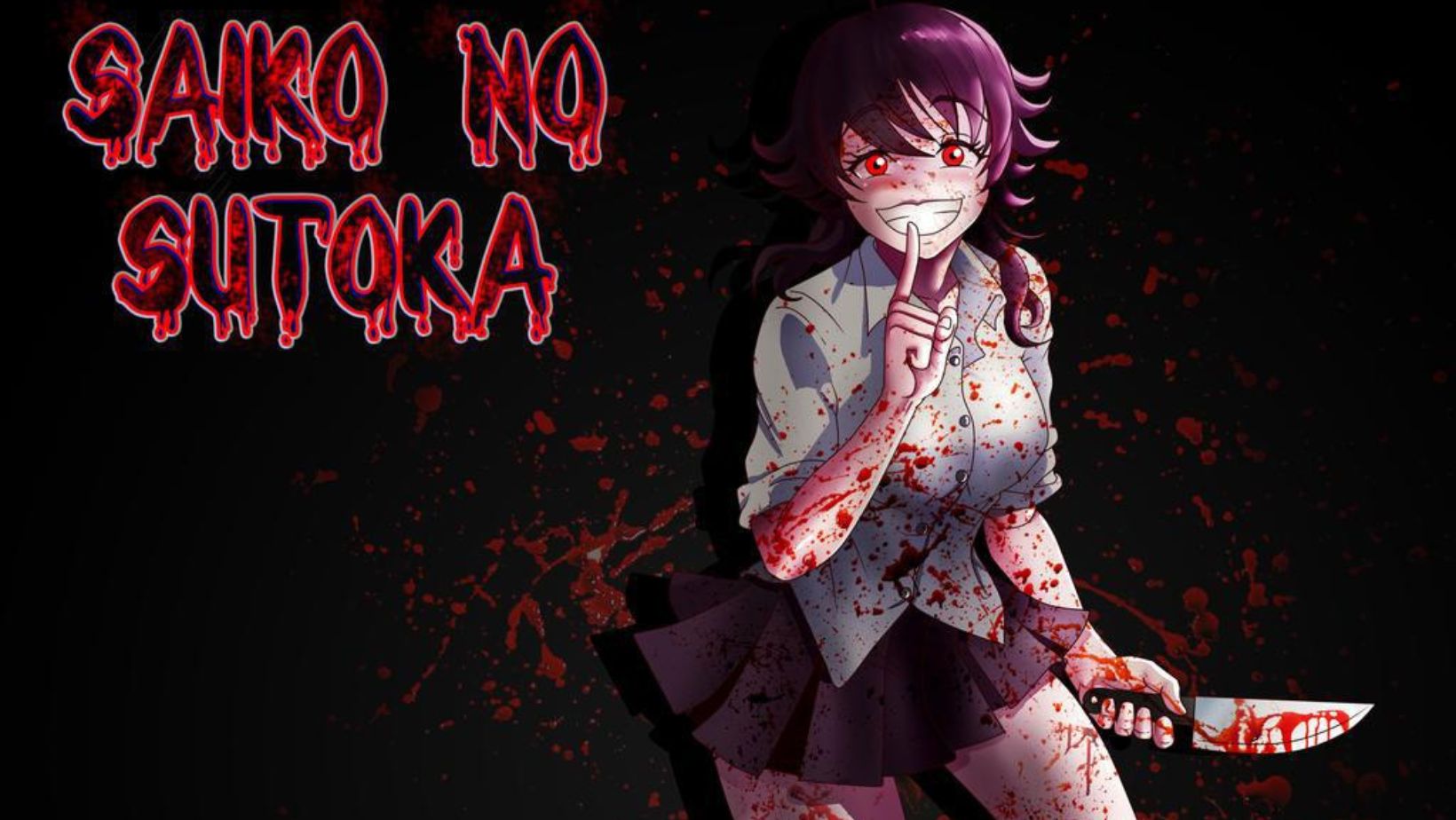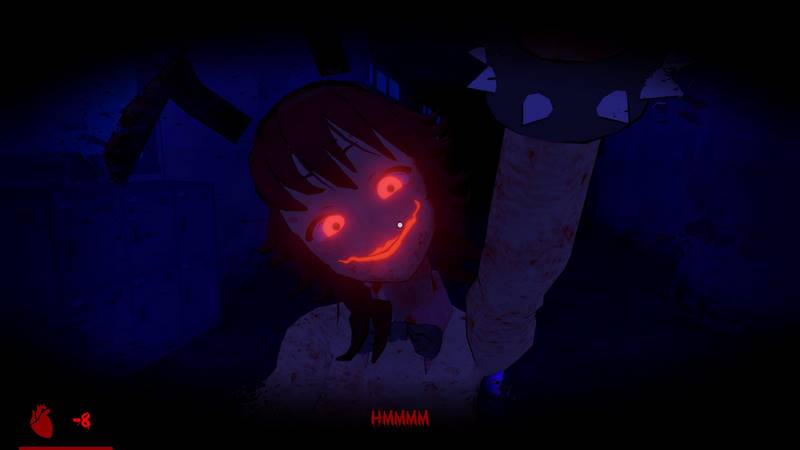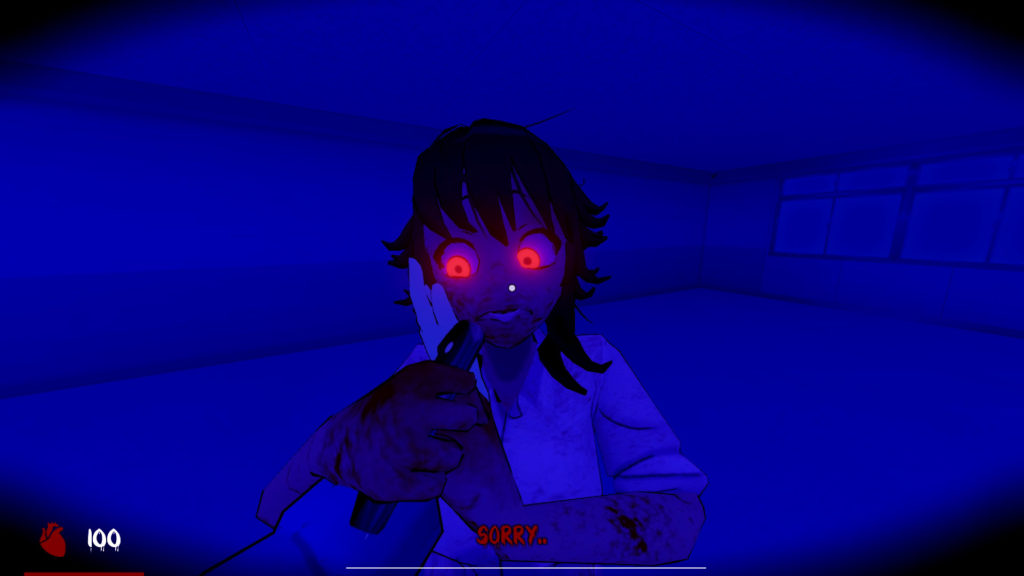
Saiko no Sutoka (Hepburn: Psycho Stalker) is a survival horror game created by independent Indonesian developer Habupain for PC. The story follows a teenage schoolboy named Akira as he finds himself trapped inside his school with his recent ex-girlfriend—a murderous yandere girl named Saiko-chan—as she tries to apprehend and kill the player. The main objective is to escape the school with your life whilst avoiding the psychotic anime girl’s killer intent.
Although still in the Alpha stage of production, Saiko no Sutoka features a fully fleshed-out range of game-play for an early build. Currently featuring four difficulty levels, the easiest setting, Yandere mode, works as a prologue to the main story. When playing as Akira’s best friend, Shinji, you spawn outside the school during the afternoon as you search for the whereabouts of your friend. Once inside, you are greeted by Saiko-chan who helps you search the school for your friend, who she refers to as senpai. This relaxed environment gives new players an important opportunity to get to grips with the gameplay along with being more lenient with mistakes.

Once completed, the game’s medium difficulty acts as its main story, picking up where the prologue left off, depending on what ending was achieved. Awakening as the admiration of Saiko-chan’s affections and the missing star of the prologue, Akira, you find yourself bound to a chair and hazy from a cocktail of drugs. After a brief cut-scene delivering some slight details to this nightmare scenario, the player is freed from their incarceration and has the ability to start their escape. A mix of typical survival horror tropes, the game-play mostly consists of key-hunting, some slight puzzle-solving elements, and an incredibly simplistic form of stealth that is utilized during attempts to evade Saiko-chan. Whilst not being outright disclosed, there are numerous ways in which this can be achieved—each offering its own unique ending to the story.
As you would expect, hard mode is the same as the previous mode, just with added difficulty. Yandere mode is the toughest difficulty available to play at the moment (the tougher Nightmare mode is disabled as the writing of this review), offering players a serious challenge as Saiko launches an all-out assault against you. Dressed in a sexy bunny suit and smeared in blood, Saiko abandons her sneaky tactics and, instead, is always hostile towards the player; doing more damage and performing more powerful attacks than in previous difficulties.

Completing these different modes is a difficult task due to Saiko-chan’s meddling, flaunting the game’s incredibly technical AI capabilities. Whilst in her stable mindset (Yandere state), Saiko-chan will not show direct hostility towards the player but will not let you escape and will attempt to stop progression by slowing you down by various means. Be it stealing items from the player’s hands, dragging the player while they’re kicking and screaming to a different area in the school, or locking the player in a classroom, Saiko-chan imbues a playful yet still sinister personality whilst in this mindset. On the contrary, whilst in Yangire state, Saiko becomes a force to be reckoned with as she stalks the player in an attempt to ambush and kill the player with her trusty kitchen knife, all whilst spouting lines about how much she loves you.
Not only does her flip between personalities seem to be linked to player actions, but it can also occur at random—providing a unique experience with each play-through. Additionally, Saiko-chan uses the environment to her advantage, laying damaging traps as well as lying in wait to ambush the player. This impressive implementation of the complex artificial intelligence is undoubtedly the game’s strongest aspect—engaging in a murderous game of cat and mouse depending on her unpredictable fluctuation between her yandere and yangire personalities.

Furthermore, a key difference between these two alternating identities, as is common in the anime style, is emphasised by Saiko-chan’s eyes. Whilst non-aggressive, her eyes seem no different than normal, but as she slips deeper into psychosis, Saiko-chan’s eyes appear to glow bright pink; a distinct visual representation that is effortlessly clear to the player, which is not only an excellent design choice but offers an incredibly eerie feeling of being watched from afar in the darkened hallways of the near-empty school.
On top of the magnificent AI, Saiko no Sutoka boasts an intricate level of sound design that performs a lot of heavy lifting during game-play. Producing an efficient level of creepy ambiance with a series of ringing notes and an unpredictable rhythm, this aspect also relays a lot of information to the player through audio cues. Distant giggles and whispers along with the ambient music increasing in intensity allude to the possibility that Saiko-chan is close by yet out of sight, waiting in ambush, creating an unquestionably anxiety-inducing manner whose effects never seem to lessen with time.

On the contrary, when it comes to Saiko no Sutoka’s visual design, there are a few underlining problems. Running on the Unity Engine, the game’s models suffer from an unnatural ‘sheen’ that is a common issue that plagues games created using the engine. Furthermore, Saiko-chan’s model has a tendency to morph into monstrous displays of unintentional body horror, with her smile terribly warped past that of a normal human which unquestionably increases the overall fear factor. Despite these misgivings, the art style certainly fits the anime universe this game is set in and in no way detracts from the game’s ability to entertain or induce fear.
A terrifying implementation of the yandere trope, Saiko no Sutoka is an incredibly atmospheric yet thoroughly enjoyable entry to the survival horror genre. Although the graphics may make the game appear to look rudimentary, it is undoubtedly anything but with its amazing AI and incredible sound design on top of its ability to foster an oppressive atmosphere.
Saiko no Sutoka is available to purchase on PC from Steam here

More Game Reviews
Gregory Horror Show is a 2003 Japanese mystery survival horror, developed by Capcom and released on PS2 in Japan and in Europe a few months later. The game is based… Released in December 2021, Vampire Survivors is a retro-style roguelike role-playing bullet hell video game that takes inspiration from the Castlevania series, developed and published single-handedly by indie developer Luca… With the Silent Hill 2 remake having received a positive reception from critics and fans alike, along with the hype surrounding Silent Hill f’s release, one may wonder: what ever… It’s no secret that H. P. Lovecraft was a massive influence on the highly successful gothic horror/action RPG Bloodborne, but perhaps not every gamer is familiar with his works. If… Choose Your Own Demise With Ashley Lister’s Novel Horror Concept UK horror author Ashley Lister likely needs no introduction to those of you who devour indie books like midnight snacks… For those who have been living under a rock for the last few years, Vtubers are a popular format of streamers who use an animated avatar in the style of…Gregory Horror Show (2003) Game Review – Strange Survival-Horror
Vampire Survivors (2021) Game Review – Bite-Size Retro Fun
Slitterhead (2024) Game Review – A Spiritual Successor to Siren with Less Horror and More Action
Five Lovecraft Stories for Those Who Liked Bloodborne
You’ve Never Experienced Horror Like This – Ashley Lister is Bloody Brilliant!
Hololive Error Teaser Demo – Video Content

Hey there, I’m Jim and I’m located in London, UK. I am a Writer and Managing Director here at Grimoire of Horror. A lifelong love of horror and writing has led me down this rabbit hole, allowing me to meet many amazing people and experience some truly original artwork. I specialise in world cinema, manga/graphic novels, and video games but will sometime traverse into the unknown in search of adventure.






